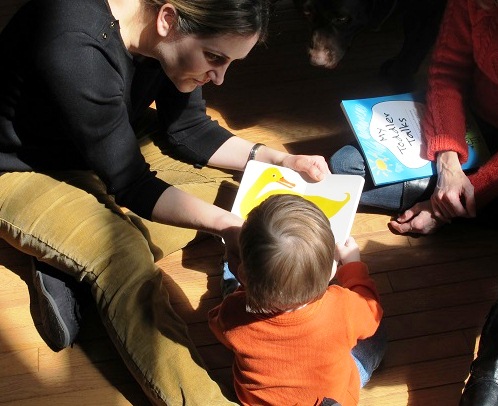Speech Therapy for Toddlers: How to Effectively Use Self-Talk and Parallel-Talk
Getting Your Toddler to Talk:
How to Effectively Use Self-Talk and Parallel Talk
You’re probably reading this post because you have concerns about your toddler’s speech and language development. If so, you’ve come to right site! Welcome to My Toddler Talks. I hope you find this site informative and helpful. I’m going to share two great techniques to help promote your toddler’s language development.
If you’re little guy is not yet talking, START your “intervention” by using:
Self-talk and Parallel talk
Self-talk is a speechie term. It simply means, talk about what you are doing, seeing, eating, touching, or thinking when your child is present. In other words, narrate your actions.
Some examples include:
“I’m washing the dishes. Now, I’m drying them. All done.”
“I see a doggie. He’s a big doggie. Jackson is a big doggie”.
“I’m cooking. I’m making mac and cheese. Yummy!”
Parallel talk is another speechie term and it’s the close brother to self-talk. To use parallel talk, talk about what your child is doing, seeing, eating, or touching. In other words, narrate what he is doing.
Some examples include:
“You’re building a big tower!” Wow!
“Uh oh, your tower fell down.”
“You’re cleaning up!”
“You threw the ball! Nice throw, Ben!
Okay, now hold it right there.
Before you even start thinking, “Oh, I already know this. I do this all the time."
Allow me a few moments to give you the opportunity to really examine if you are using these techniques to their fullest potential.
Firstly, when using self-talk and parallel talk, you are not requiring your child to imitate what you are saying. Please do not have the expectation that your child is automatically going to repeat you. These techniques simply give your child exposure to language during play and daily routines. We’re using self-talk and parallel talk to expose the child to words and to make them realize that talking is fun AND functional. These techniques help to bridge the gap between a child who may not yet realize that objects, actions, and feelings, have names and they can be labeled and spoken about. If they imitate or repeat you, that’s wonderful, but it’s not expected at this point.
Self-talk and parallel talk should not be a play by play. If you’re getting winded (a very bad sign) or you notice that you’re doing all the talking, than you’re overdoing it.
Use words and phrases that are age appropriate. Some children may better understand if only one or two words are said (e.g. “washing dishes,” “drying dishes,” and “all done”), rather than longer phrases or sentences.
Most importantly - Do not use self-talk and parallel talk to divert their attention away from what they are interested in. If your child is earnestly looking at a pinwheel, a sticker, or whatever is striking his fancy – talk about THAT. Do not break his focus by turning away his attention to something that you are doing or saying. We’ve all done this before, but we have to remember that toddlers learn best when we follow their lead and interests. Janet Lansbury, over at Elevating Child Care, has a fantastic post where she shares 7 Ways to Build Your Child's Focus and Attention Span. It's worth checking out.
Here’s an example of how we may be tempted to break our child's focus:
Benny is playing with his blocks and earnestly trying to stack them. He appears much focused on the task. You’re reading a magazine (as if! More like you’re scrambling to clean up the house, but this is a hypothetical here) and you see a cool picture of a train (one of Benny’s favorite things). Seeing this fantastic train picture makes you eager to use parallel talk ("Benny, I see a picture of a train!"). However, it also means that you would have to interrupt his play to tell him about the picture Hmmmm...what should you do?
In a case like this, I would probably use self talk once or twice to talk about his awesome block tower! I would wait to show him the train picture until there's a natural break and when he switches gears to something else. Believe me perfect implementation is challenging. We are very prone to accidentally distracting babies and toddlers because we think what we have to say or show them is so important. I'm even guilty of doing this sometimes with my own 10 month old! However, if your child is concentrating on something, give him time to examine and explore it.
I hope this post has been helpful to you!
How can you use self-talk and parallel talk with you toddler? I would LOVE to hear from you!
If you are in need of some additional free and helpful resources, please subscribe to my newsletter - I share more information exclusively with my newsletter subscribers.
If you have enjoyed reading My Toddler Talks, please help spread the word about my book. Please tell your friends, write an honest review on Amazon, click the Facebook like button on landing page, or personally give me your feedback. I love hearing from my readers and value their input. You are the reason why I devote so much time to perfecting my craft :)

